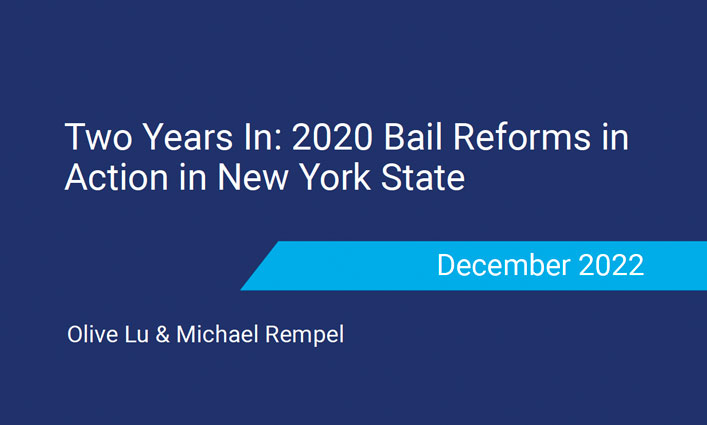
John Jay College’s Data Collaborative for Justice Study Examines Statewide Bail Reform Impact in 2020 and 2021
Less bail-setting, higher amounts when bail is set, and persistent racial disparities are among the results for the first two years after new bail laws were put into effect in New York, according to a new report from the Data Collaborative for Justice at John Jay College of Criminal Justice. New York’s bail reform law sought to reduce pretrial detention, limit the role of money in whether people can secure their liberty while presumed innocent of a crime, shrink racial disparities, and maintain public safety.
The study begins to provide some hard data to support the conversation surrounding bail reform, which has been a lightning rod for debate (and, at times, misinformation) in the political, criminal justice, and public arenas. The debate thus far has largely focused on the impact of reform on public safety—the subject over which evidence to-date is least clear—while underemphasizing findings on whether reform has achieved legislators’ aspirations to advance pretrial justice and equity.
DCJ’s new report assesses the statewide impact of the reforms on judicial decision-making, affordability of bail, and racial disparities two years post-implementation.
On January 1, 2020, landmark reforms governing bail and pretrial release decisions went into effect in New York State. The new laws eliminated bail for most misdemeanors and non-violent felonies, required judges to consider people’s ability to pay in cases still legally eligible for bail, and included a new presumption of release on recognizance in all cases except when an individual poses a “risk of flight.”
Amendments to the reforms went into effect in July 2020, moving some charges that had become ineligible for bail back into the bail-eligible category.
“DCJ is proud to continue to provide comprehensive data to inform the ongoing debate on the impact of bail reform in New York State,” said Olive Lu, Associate Director of Research, Data Collaborative for Justice (DCJ). “Our latest report finds that while some aspects of the law are being adhered to, such as judges increasing the use of release with non-monetary conditions, there remains implementation gaps, especially in the setting of affordable bail.”
“The actual data on New York’s bail reform doesn’t lend itself to easy soundbites,” said Michael Rempel, Director, Data Collaborative for Justice. “With this report, we sought to examine how the reform is faring on three of its many goals: reducing the use of bail, making it more affordable, and curtailing racial disparities. Perhaps unsurprisingly, our results point to a mix of both successes and shortcomings. We hope this and other research can aid policymakers seeking to improve future implementation.”
Some Key Findings:
- Less Bail and Pretrial Detention: Overall, judges’ use of bail or direct remands to jail declined from 2019 to 2020; and then remained stable from 2020 to 2021.
- Large 2021 Declines in Release on Recognizance (ROR): From 2020 to 2021 there were declines for all charges in judges’ frequency of releasing people on their own recognizance (without conditions).
- Increases in Non-Monetary Conditions: Consistent with the reformed statute’s intent, judges use of supervised release increased from 2019 to 2021.
- Regional Differences: In general, NYC judges were less likely to set bail or remand than judges in Upstate or Suburban New York (both pre and post reform).
- Higher Bail Amounts and Lower Rates of Payment: Although the reform requires considering what people can afford when bail is set, judges set higher bail amounts within the 2020-to-2021 implementation period. In turn, the percentage of people who posted bail at arraignment significantly declined from 26% in 2019 to 18% in both 2020 and 2021.
- Persisting Racial Disparities: While all groups saw their lowest rates of bail/remand in the first quarter of 2020 and higher rates thereafter, Black people faced consistently higher rates of bail or remand throughout both 2020 and 2021 compared to Latinx and white people.
Glossary of Terms
Bail: Bail is money or other forms of security given to the court at arraignment in exchange for release from pretrial detention and an individual’s promise to return to court for their next court date.
Release on Recognizance (ROR): At arraignment, judges may decide to release individuals from pretrial custody without setting bail or non-monetary conditions (e.g., supervision, treatment mandate), while the case is pending.
Remand: Judges may alternatively decide to return individuals to jail pending their next court date, without the possibility of release with bail or non-monetary conditions.
The full report is available on the Data Collaborative for Justice’s website.
The Data Collaborative for Justice (DCJ) leads critical research about frequent interactions between community members and the criminal legal system and aims to ensure that communities, and the governments that serve them, have the necessary information to develop and implement evidence-based policies, practices, and programs. DCJ’s work has informed policy reforms, facilitated partnerships between researchers and government agencies across the country, spurred new scholarly research on lower-level enforcement, and been cited extensively in the press. More information about the Data Collaborative for Justice’s work is available at: www.datacollaborativeforjustice.org.
This analysis and report was generously supported by Arnold Ventures.



